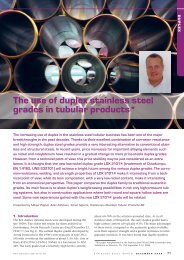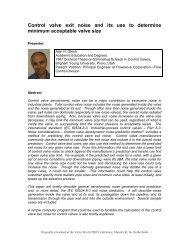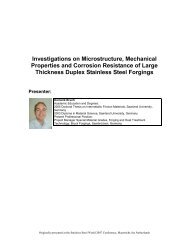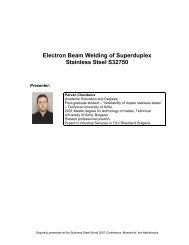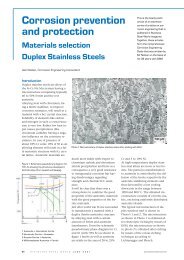Duplex stainless steel welding: best practices*
Duplex stainless steel welding: best practices*
Duplex stainless steel welding: best practices*
Create successful ePaper yourself
Turn your PDF publications into a flip-book with our unique Google optimized e-Paper software.
presence of ferrite in DSS imparts<br />
the superior CSCC resistance and<br />
high strength. On the other hand,<br />
austenite in DSS provides the high<br />
aqueous corrosion resistance and<br />
low temperature impact toughness.<br />
The recommended phase balance of<br />
DSS and SDSS should contain 40-<br />
60% ferrite in the base metal and<br />
35-60% ferrite in the weld metal.<br />
Special consideration must be given<br />
to the narrow-HAZ. It is essential to<br />
have a discontinuous fine grain microstructure<br />
of ferrite and austenite<br />
in the narrow region.<br />
DSS shows rather complex precipitation<br />
behaviour due to the high<br />
amount of alloying elements. The<br />
formation of carbides, nitrides and<br />
intermetallic phases, which can be<br />
detrimental, will begin to form in<br />
short periods of time as cooling proceeds<br />
to lower temperatures in the<br />
range of 475-955°C (887-1750°F).<br />
For this reason DSS should not be<br />
used at temperatures above 300°C<br />
(570°F).<br />
Optimum DSS welds depend on<br />
multiple factors such as engineering<br />
design, material selection, pre/postweld<br />
cleaning, joint preparation and<br />
most importantly, choice of a suitable<br />
<strong>welding</strong> process. Guidelines<br />
supplement API 938C and provides<br />
recommendations for WPS and PQR<br />
development to achieve an optimum<br />
ferrite to austenite balance<br />
during <strong>welding</strong>.<br />
More than<br />
20 years of Competence<br />
Our<br />
grades:<br />
References<br />
1. API Technical Report 938-C. 2005. Use of <strong>Duplex</strong> Stainless Steels in the Oil Refining Industry:<br />
American Petroleum Institute: First Edition. Washington, D.C.<br />
2. Davis, J.R. Corrosion of Weldments: ASM International ® (2006): Materials Park, OH 44073-002.<br />
3. Gooch, T.G., Leonard, A.J., and Gunn, R.N. 2000. Hydrogen cracking of ferritic-austenitic <strong>stainless</strong><br />
<strong>steel</strong> weld metal (DA2_058): Stainless Steel World: Page 354-357.<br />
4. Sieurin, H., and Sandström, R. Austenite Reformation in the heat-affected zone of duplex <strong>stainless</strong><br />
<strong>steel</strong> 2205: Material Science Engineering A 418 (2006) 250-256.<br />
5. Pohl, M., Storz, O., Glogowski, T. Effect of intermetallic precipitations on the properties of duplex<br />
<strong>stainless</strong> <strong>steel</strong>. Material Science Engineering 58 (2007) 65-71.<br />
6. ASTM © Standards A 923, Standard Test Methods for Detecting Detrimental Intermetallic Phase in<br />
Wrought <strong>Duplex</strong> Austenitic/Ferritic Stainless Steels.<br />
7. ASTM © Standards A 380, Standard Practice for Cleaning, Descaling, and Passivation of Stainless<br />
Steel Parts, Equipment, and Systems.<br />
8. BS 6787:1987, ISO 8249:1985. Determination of ferrite number in austenitic weld metal deposited<br />
by covered Cr-Ni <strong>steel</strong> electrodes: British Standard.<br />
About the authors<br />
Barry Messer is<br />
Technical Director and<br />
Senior Fellow for<br />
Materials and Welding<br />
Engineering with Fluor<br />
Canada Ltd. and a director<br />
with the<br />
Canadian Welding Bureau. Barry has<br />
over 30 years experience in metallurgy,<br />
<strong>welding</strong>, and NDE development and<br />
material selection. He is regularly involved<br />
in the analysis and mitigation of<br />
fabrication and in-service failures for<br />
the chemical, petroleum, power, and<br />
mining industries.<br />
barry.messer@fluor.com<br />
Vasile Oprea is a<br />
Senior Metallurgical<br />
and Welding Engineer<br />
with Fluor Canada Ltd.<br />
He has over 25 years<br />
experience in material<br />
selection, <strong>welding</strong>, heat<br />
treatment, NDE, and failure analysis.<br />
Andrew Wright is a<br />
metallurgical Engineer<br />
with Fluor Canada Ltd.<br />
He provides <strong>welding</strong><br />
and metallurgical support<br />
for piping and<br />
equipment fabrication.<br />
Andrew is currently involved in high alloy<br />
<strong>welding</strong> issues on international<br />
petrochemical projects.<br />
www.<strong>stainless</strong>-<strong>steel</strong>-world.net S T A I N L E S S S T E E L W O R L D D E C E M B E R 2 0 0 7 63<br />
<strong>Duplex</strong><br />
Heat-Resistant Stainless Steel Tubes<br />
We offer one of the widest ranges in Europe<br />
1.4713<br />
TP 409 1.4720<br />
TP 405 1.4724<br />
TP 430 1.4742<br />
TP 446 1.4749<br />
TP 446 1.4762<br />
TP 327 1.4821<br />
TP 309 1.4828<br />
TP 314 1.4841<br />
TP 310s 1.4845<br />
TP 330 1.4864<br />
Alloy 800 1.4876<br />
Schenk Stahl GmbH<br />
P.O. Box 27 03 38, D-40526 Düsseldorf, Germany<br />
Tel: +49 2131 230-37, Fax: +49 2131 230-35<br />
info@schenk-stahl.de, www.schenk-stahl.de<br />
TP 32/27 1.4877<br />
TP 321 H 1.4878<br />
Alloy 600 2.4816<br />
Alloy 601 2.4851<br />
Alloy 625 2.4856<br />
Alloy 825 2.4858<br />
·SCHENK·<br />
H E A T-RESISTANT<br />
T U B E S



